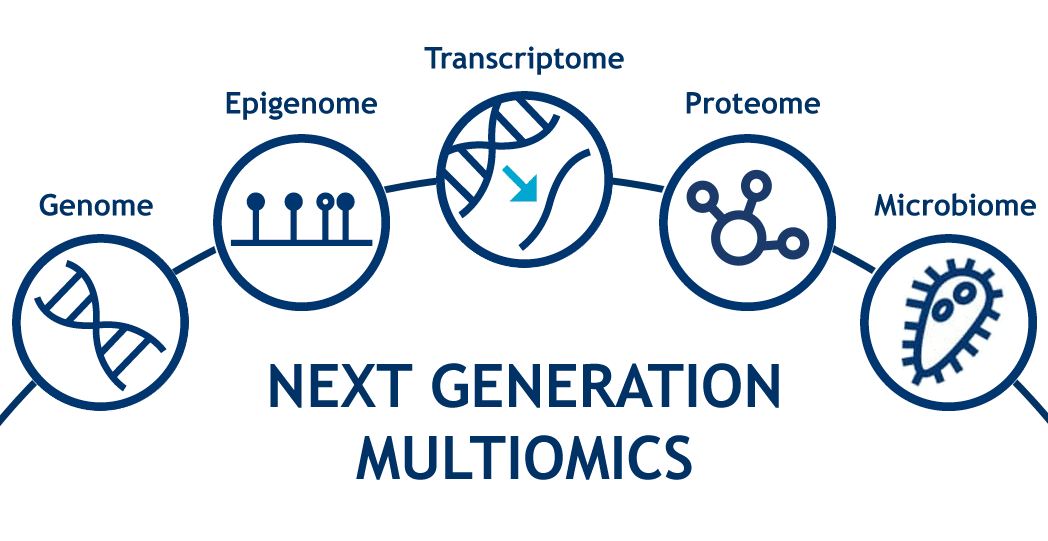‘Next generation’ proteomics with Proximity Extension Assay (PEA) technology
For years, technologies to detect or quantify proteins have been limited in applicability due to low throughput, poor sensitivity and specificity, and large sample volume requirements. However, recent technological developments are elevating high-throughput proteomics to mainstream. GenomeScan is partnering with Olink Proteomics to bring proteomics to the next level by enabling high-throughput analysis of thousands of proteins, while using less than a drop of blood. Olink’s PEA technology that is based on dual antibody recognition results in the coupling of DNA oligonucleotides and boasts exceptional levels of specificity, sensitivity and dynamic range. At GenomeScan, we bring this technology together with our genomics, transcriptomics, and epigenomics expertise, and help you gain actionable insights into health and disease in a fast and effective way.

Proteins: Dynamic indicators of disease, most actionable targets for therapeutics
The central dogma of molecular biology maps out the information flow from DNA to its transcription to RNA, and translation to proteins, the latter forming the building blocks of organisms. Each step in this process has multiple modulators that behave in a cell, time, and disease-state specific manner. Because of this, proteomics analyses became an important bridge between genes and the ultimate phenotype.
- Proteins are the executors of most biological processes (e.g. enzymes, cytokines, transcription factors).
- They are dynamic indicators of phenotype in health and disease.
- The most actionable targets for therapeutic interventions are proteins (proteins are the targets of most current drugs).
How does PEA technology work?
The PEA technology works in 3 steps: Antibody pairs, labelled with DNA oligonucleotides, bind target antigen in solution. Then, oligonucleotides that are brought into proximity hybridize and are extended by a DNA polymerase. Finally, this newly created piece of DNA barcode is ready to enable protein quantification.
The dual binding of antibodies and DNA coupling together provide an exceptional specificity. In case of non-specific binding of antibodies, the oligonucleotides cannot hybridize and no signal will be generated.
15 carefully designed panels
Olink® Target 96 & 48 panels for targeted protein biomarker discovery enable high-multiplex immunoassays that do not compromise on either data quality or performance. Each Target 96 panel can perform 92 validated assays using 88 samples and Target 48 (cytokine) panel allows for simultaneous analysis of 45 protein biomarkers using 40 samples. Olink Target 96 panels cover key disease areas and biological processes including:
- Neurology
- Cardiometabolic
- Cardiovascular
- Inflammation
- Immuno-oncology
- Oncology
- Organ damage
- Development
- Metabolism
- Cell regulation
~1 µl from a range of samples

Olink panels are compatible with various sample types including:
- Human Plasma & Serum
- Cerebrospinal fluid (CSF)
- Urine
- Tissue lysate
- Interstitial fluid/microdialysis
- Ocular fluids
- Saliva
- Synovial fluid
- Fine needle biopsies
You can request a list of protein assays and validation data documents relevant to your field. Or you can access the full list here.
Multiomics approaches to research
Multiomics is a rapidly growing field that integrates multiple types of “omics” data, including genomics, epigenomics, transcriptomics, proteomics, and metabolomics, to provide a comprehensive understanding of biological systems. What makes multiomics so attractive is its ability to capture a more complete picture of biological processes, as each “omic” layer provides unique information about the functioning of the system.
By combining different omics approaches, GenomeScan helps you identify the regulators of biological processes, identify new targets for drug discovery, evaluate therapeutic interventions, and identify biomarkers that can be used for diagnosis, prognosis, and disease monitoring, leading to more precise and effective treatments.

Let's get the conversation started for your next proteomics project
Please fill out the form below or email us directly at info@genomescan.nl and we will get in touch with you to discuss your requirements.

